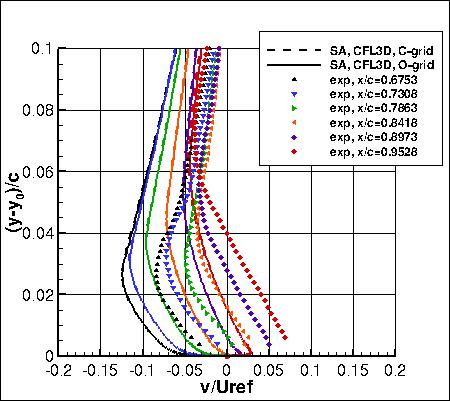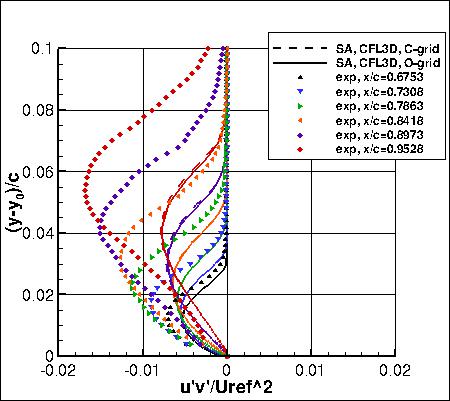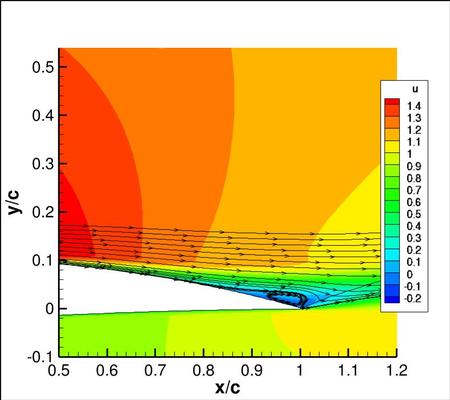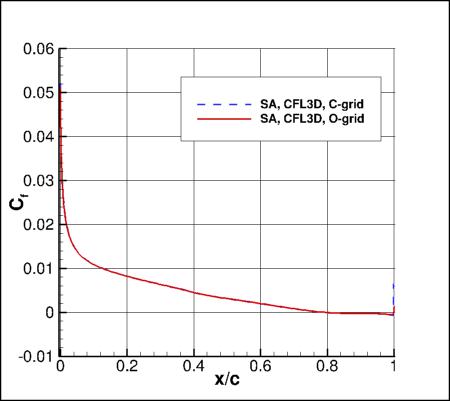 |
Langley Research CenterTurbulence Modeling Resource |
Return to: 2D NACA 4412 Airfoil Trailing Edge Separation Case SA Page
Return to: 2D NACA 4412 Airfoil Trailing Edge Separation Case Intro Page
Return to: Turbulence Modeling Resource Home Page
2D NACA 4412 Airfoil Trailing Edge Separation Validation Case
SA Model Results on Auxiliary O-grid
Link to SA equations
Note that thorough
grid studies were not performed for validation cases such as this one.
Some effort was made to ensure reasonable grid resolutions, but there may still be
small noticeable discretization errors. Therefore, these validation results shown should be considered
representative, but not "truth."
The plots shown compare the SA results from CFL3D
on two different grids, the
original 897x257 C-grid (with closed trailing edge) and the
auxiliary 481x253 O-grid (with finite thickness trailing edge).
Results are very close.
Uref in the plots has been scaled as described on the
2D NACA 4412 Airfoil Trailing Edge Separation Case Intro Page.
CFL3D used freestream value of the SA turbulence field variable (relative to laminar)=3.
Please read note 5 on Notes on running CFD page.
Standard lift and drag coefficients on the O-grid (based on the freestream conditions listed on the Intro Page) were: CL=1.715 and CD=0.0285.
CFD surface pressure and skin friction coefficients shown in the plots above were based on the freestream conditions.
Note that these are compressible code results at "essentially incompressible" conditions of M=0.09.
There may be a very small influence of compressibility.
It is important to note that the experimental u, v, and u'v' data were nondimensionalized with respect to
a non-traditional velocity at a location only about 1 chord below and behind the airfoil. This is different from a
traditional "freestream" value. As a result, u/Uinf and v/Uinf values from CFD
need to be divided by roughly 0.93 in order to be
comparable to the experimental normalization u/Uref (where Uinf is the usual farfield freestream value
and Uref is the experimental reference location). Similarly, u'v'/(Uinf2) turbulence values from CFD need to be
divided by approximately 0.932. However, the surface pressure coefficients from CFD agree better with
the experiment on the airfoil lower surface when no such correction is made (the matching of the lower surface
Cp is often used as a way to determine whether or not the flow conditions are consistent). The reason for
this inconsistency is not known. Therefore, all comparisons for this case should only be viewed in a
qualitative sense. Neither the surface pressure coefficients nor the surface skin friction coefficients
from the CFD have been adjusted.
Return to: 2D NACA 4412 Airfoil Trailing Edge Separation Case SA Page Return to: 2D NACA 4412 Airfoil Trailing Edge Separation Case Intro Page Return to: Turbulence Modeling Resource Home Page
Recent significant updates: Responsible NASA Official:
Ethan Vogel






07/28/2016 - added plot of upper surface Cf
03/27/2015 - updated plots to reflect proper y-offest in exp data
Page Curator:
Clark Pederson
Last Updated: 02/21/2018